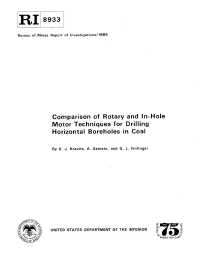Mining Publication: Comparison of Rotary and In-Hole Motor Techniques for Drilling Horizontal Boreholes in Coal
Original creation date: January 1985
This Bureau of Mines report describes and compares the procedures, capital investments, and operating costs of rotary and in-hole motor drilling techniques used to drain methane gas from the Pittsburgh coalbed in an underground mine located in southwestern Pennsylvania. A timestudy was conducted during the drilling of each of two boreholes, and the data were collected to serve as a base for comparing drilling procedures and operating costs. Findings indicate that drilling with an in-hole motor offers four advantages over rotary drilling; namely, an increase in drilling productivity, fewer worker-hours required, ease of maintaining vertical and horizontal bit trajectory, and less expensive drilling cost per foot of borehole.
Authors: SL Kravits, A Sainato, GL Finfinger
Report of Investigations - January 1985
NIOSHTIC2 Number: 10004416
Pittsburgh, PA: U.S. Department of the Interior, Bureau of Mines, RI 8933, 1985 Jan; :1-31
See Also
- Cableless Electronic Surveying Systems for Horizontal Holes
- Coal Mine Methane: A Review of Capture and Utilization Practices with Benefits to Mining Safety and to Greenhouse Gas Reduction
- Correlation of Sonic Travel Time to the Uniaxial Compressive Strength of U.S. Coal Measure Rocks
- Demonstration of Remote Mine Seal Construction
- Detecting Strata Fracturing and Roof Failures from a Borehole Based Microseismic System
- Effects of Stimulation Treatments on Coalbeds and Surrounding Strata: Evidence from Underground Observations
- Horizontal Trajectories of Rotary-Drilled Holes
- Removing Methane (Degasification) from the Pocahontas No. 4 Coalbed in Southern West Virginia
- Rotary Drilling Holes in Coalbeds for Degasification
- Use of Vertical Boreholes for Assisting Ventilation of Longwall Gob Areas
- Content source: National Institute for Occupational Safety and Health, Mining Program


 ShareCompartir
ShareCompartir
